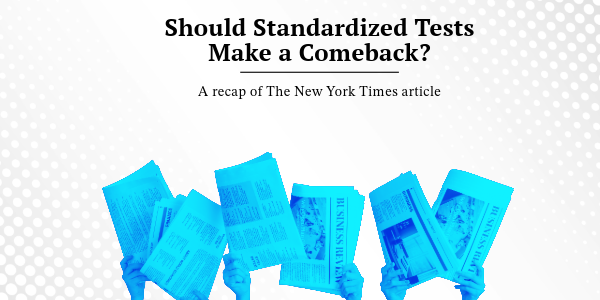The New York Times recently wrote an article about the misguided information surrounding standardized tests such as the SAT/ACT. Now, some experts and universities are wondering if a test-optional approach is truly beneficial for both the student and university or if it’s time to bring back testing requirements. Below is a recap of the New York Times post..
In the wake of the Covid-19 pandemic, numerous selective colleges temporarily abandoned SAT and ACT requirements for applicants. While initially framed as a response to pandemic-related challenges, the shift towards test-optional policies has persisted, sparking debates about their impact on equity in higher education.
Originally hailed as a victory for fairness, some experts and university administrators are now questioning whether the move was a mistake. Recent research indicates that standardized test scores offer valuable insights into predicting college success, graduation rates, and post-college achievements. Despite concerns about test-related stress and biases, proponents argue that these scores provide a more reliable metric than high school grades, which are susceptible to grade inflation.
Test-Optional Approach
Critics of the test-optional approach suggest that removing standardized tests makes it challenging for admissions officers to distinguish between applicants likely to excel at elite colleges and those who may struggle. Research has shown that test scores can be particularly beneficial in identifying lower-income students and underrepresented minorities with great potential.
The debate over standardized testing in college admissions intersects with broader issues of inequality, affirmative action, and the purpose of higher education. While some view tests as an unfair barrier, others argue that they serve as a critical benchmark, especially given existing biases in other parts of the admissions process.
Data from studies, including one covering Ivy Plus colleges, indicates a limited relationship between high school grades and college success, emphasizing the predictive power of test scores. However, the reluctance to reinstate test requirements is attributed to political factors, with standardized tests facing opposition from progressive circles concerned about racial and economic disparities.
The article explores the case of M.I.T., which reinstated its test requirement, emphasizing that scores are not the sole determining factor. M.I.T. achieved a diverse class by using test scores to identify promising applicants from less advantaged backgrounds. This approach challenges the assumption that standardized tests hinder diversity.
College Admissions
Ultimately, the debate revolves around whether standardized tests should be one of several criteria in admissions decisions. Critics argue for a more fundamental shift in the admissions process, favoring a lottery system based on minimum requirements. However, supporters of standardized tests contend that they provide an objective benchmark amidst the subjectivity of other application components.
As colleges grapple with the test-optional dilemma, the article suggests that the progressive rejection of standardized tests may be a polarized position not entirely grounded in empirical evidence. While seeking to reduce inequities, the test-optional trend may inadvertently deny opportunities to lower-income, Black, and Hispanic students who could benefit from these tests.
Conclusion
In conclusion, the article underscores the complexity of the standardized testing debate, emphasizing the need for a nuanced approach that considers both equity concerns and the valuable insights these tests can provide in identifying talented and diverse student populations.



Joseph T. Trevathan
I didn’t realize that some colleges had changed their testing policies due to Covid. I assume someone is tracking the results of those changes.
GSPAdmin
Hi Joe T,
Test Optional policies began being tested at colleges in the northeast in the early 2000s with mixed results. In the late 2010s, there were a number of organizations and individuals/departments on some campuses that decided that accepting test scores weren’t fair to some students and strong advocated the elimination of testing. As the NY Times article alludes, the UC system spend 18-20 months researching admissions requirements (spearheaded by a couple dozen UC professors and initiated by Janet Napolitano when she was the System President). After their extensive research showed that test scores were the most fair (i.e. least biased) metric (more than GPA, essays, interviews, extra-curricular activities, campus visits, etc) the 50 Regents (mostly politicians and other California elite) disregarded their own research and voted unanimously to eliminate test scores from the admission requirements. They are now what’s called, Test Blind (essentially if a student sends their scores on the ACT or SAT, they essentially immediately go into the virtual trashcan).
When COVID hit, the pandemic provided cover for removing testing from requirements at most schools – as many students weren’t able to take an exam due to closures. Some may say that removing this data point at this moment was the worst time to implement the policy, given that all of the other admission factors were also essentially canceled – leaving the admission decision to be as subjective as possible. Some schools suspended typical grading for Pass/Fail and most other schools simply provided much higher grades in the face of students mastering topics at a lower rate (i.e. grade inflation).